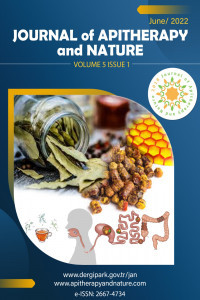Propolis Included Chewing Gum and Investigation of Its Antibacterial Activity against Streptococcus mutans
Propolis Included Chewing Gum and Investigation of Its Antibacterial Activity against Streptococcus mutans
Propolis, Antibacterial Activity, Streptococcus mutans,
___
- .
- Yayın Aralığı: Yılda 2 Sayı
- Başlangıç: 2018
- Yayıncı: Oktay YILDIZ
Propolis: A Natural Product – Great Potential as a Medicine
Determination of Phenolic Acids in Raw Propolis Using Near Infrared Spectroscopy
Ana María VIVAR-QUINTANA, İsabel REVILLA, María İnmaculada GONZÁLEZ-MARTÍN, Eddy Valentín BETANCES-SALCEDO
The Impact of Honeybee Origin on the Quality of Propolis
Gomes da Silva CAHANGO, Soraia I. FALCÃO, Miguel VILAS-BOAS
Erzsébet-timea DOMOKOS, Adriana URCAN, Liviu Alexandru MARGITAS, Daniel Severus DEZMIREAN, Otilia BOBIS
GC-MS and UPLCA-PDA-TOF Profile of Polish and Eurasian Propolis
Jarosław WIDELSKI, Piotr OKIŃCZYC, Antoni SZUMNY, Jakub SZPERLIK, Anna KULMA, Zbigniew SROKA, Krystyna SKALICKA-WOŹNIAK, Tomasz MROCZEK
An Overview of Chemical Studies and Biological Activities of Mediterranean Propolis
Konstantia GRAIKOU, İoanna CHINOU
Direct Visualization of Artepillin C into Fibroblast Cells via CARS Microscopy
Wallance M. PAZIN, Vita SOLOVYEVA, Tibebe LEMMA, Bjarke JØRGENSEN, Carlos José L. CONSTANTINO, Jonathan BREWER
Antimicrobial Effect of Commercial Propolis Extract (BEEO©)
Aslı Elif TANUGUR, Sevgi KOLAYLI, Merve KESKIN, Sengul ALPAY KARAOGLU
Chemical Profile and Botanical Origin of Stingless Bee Propolis from Thailand and Indonesia
Antituberculosis Activity of Propolis
Jarosław WIDELSKI, Joanna GOLUS, Piotr OKIŃCZYC, Rafał SAWICKI, Grażyna GINALSKA, Tomasz MROCZEK, Zuriyadda SAKIPOVA, İoanna CHINOU, Krystyna SKALICKA-WOŹNIAK
